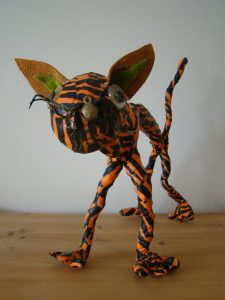The importance of creative activities for a child’s development, learning and well-being.
Written by: Professor Lene Tanggaard, Ph.d. Aalborg Universitet
(Translated from Danish to English)
Theatre, music, dance, art. It is difficult to imagine a life without it. As humans, we express ourselves with words, sounds, body language and pictures. We tell stories. We shape things that are greater than ourselves. We show each other and our children, that life is worth living and its countless thrilling and thought-provoking experiences, tales and impressions.
Humans are biological living creatures, but also users of signs, symbols and languages. We eat, and we set the table, maybe a bit nicer, when having guests. We give birth to children, help them get dressed and give them names. On roads, streets and alleyways, we navigate by using signs and symbols.
We can’t avoid the cultural and aesthetic, when attempting to understand to the human life. That is why creativity is essential for the child’s development, learning and well-being. This is where children and adults in collaboration, learn about their own and others culture, while benefitting from the art and culture offered to us.
In cultural psychology, which I have completed, we particularly deal with these aesthetic, creative psychological functions, that builds upon the basic biological aspects. Humans are cultural creatures. We shape and recreate culture. We imagine the future, and we visualize memories and images of the past with the help from our imagination. The creative and active part of the human have for several years formed the foundation of my research interests in creativity and creative learning environments. In the following section, I will briefly give you an impression of the research and knowledge we have, about the importance of creative activities for children’s development, learning and well-being. Here’s a summery with headlines:
Complex and comprehensive creative learning processes
When children play music, do theater, sing in choirs, paint a painting or does an experimental performance, they get an opportunity to play and experiment. They work with different materials, learning their roles and how to express themselves with words, sound, images and with their body. The children experience working with other people, and often the activities lead to events, where they have to perform.
It is almost obvious, that it helps with the development. It is evident, that the child learns. The music may be from a former century or a modern composer. Theater has a writer and director, trying to bring out a message. The drama can tell a story. There’s history and life in art. The child may read along – say a line – practice their singing voice – concentrate with the brush. The child may have to be courageous and speak in front of other people. The child may learn to be with others, while cooperating and compromising. These are, after all, quite complex and comprehensive learning processes.
Happiness, imagination and urge for creativity
Kulturskolen is a fascinating place. This is a place where children meet adult teachers, that lives by the art. There is nothing more joyful, than a successful performance with an audience filled with excited parents, locals or other children. To prepare and feel anticipation, joy and anxiety.
To feel the importance. To feel that something is at stake.
When children, for example, have to do a performance or take part in an artistic creation process, they get an opportunity to utilize their imagination into their work. They have to use their imagination and work out something new, that doesn’t already exist. The more one uses their imagination, the more one can develop and access that part of existence and the more one dares to imagine the world differently. It is important for children (and others) that the imagination, can be a place to go and explore. Of course, a practiced imagination can also be a great help when writing assignments in school, drawing or developing new ways to finish tasks at home, work and other places.
We should celebrate more often.
Lately in Denmark, we have been very focused on our children learning mathematics and languages. Those are important subjects; however, a child’s learning path is far more than just a functional set of skills like reading, writing and solving math assignments. As stated above, it is also important to be able to create new things, prepare a performance and learn to cooperate with other people. That is what you learn on Kulturskolen. Of course, you can learn this from other places, but this is a great place to begin. As cultural creatures, we should celebrate the creative learning processes far more than nowadays. They are vital for our existence and are connected to some of the most complex learning processes. In addition, it also gives cause for happiness, concentration and connection to the past and the future. That should be worth celebrating more. Some people say we should live by it. I believe that we should live with and through culture.
References:
http://hansreitzel.dk/P%C3%A6dagogik/FAQ-om-kreativitet/9788741261713
